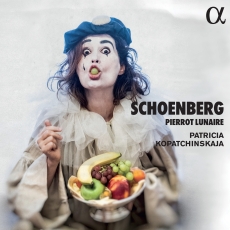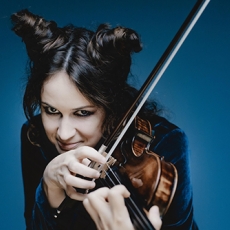Patricia Kopatchinskaja - Schoenberg: Pierrot lunaire - Europadisc
The background to this new recording of Arnold Schoenberg’s early modernist masterpiece, the song-cycle Pierrot lunaire, is almost as remarkable as the performance itself. When in 2015 the brilliant, iconoclastic violinist Patricia Kopatchinskaja was forced by an attack of tendonitis to cut down on her playing, she immersed herself in learning to perform Pierrot’s formidably demanding Sprechstimme (‘speech-song’) vocal part, and has since made something of a speciality of the role with various international ensembles. Her palpable sense of involvement in the project has its roots in her passion for the music of the Second Viennese School, an enthusiasm she clearly shares with the hand-picked members of the ensemble on this recording, a classy line-up including pianist Joonas Ahonen and cellist Thomas Kaufmann.
While most performances of Pierrot lunaire are led by a classically-trained soprano in the ‘title’ role, Schoenberg originally composed these ‘three times seven’ songs (to texts by Albert Giraud, in the German translation by Otto Erich Hartleben) for cabaret-style performance by the actress Albertine Zehme, who was experienced in the art of melodrama: the recitation of spoken texts over a musical accompaniment. Artists including jazz singer Cleo Laine, actress Barbara Sukowa and even singer-songwriter Björk have continued this tradition, so that the assumption of the role by a classical violinist might seem positively strait-laced by comparison. This performance, however, most certainly isn’t! While following fairly closely the contours and pitches of the carefully-notated vocal line, Kopatchinskaja’s rendition is arguably more speech than song, revelling in and often exaggerating the consonants of Hartleben’s German text. At times, purists might feel that the element of self-mockery is too much to the fore, yet Schoenberg himself spoke of the work’s ‘light, ironic-satirical tone’, and it is to this that PatKop’s performance repeatedly returns.
Often, as in her explosive account of the third song (‘Der Dandy’) or the voice-and-flute seventh (‘Der kranke Mond’ / ‘The sick moon’), Kopatchinskaja seems to tap into the ‘animalistic’ immediacy of expression about which Schoenberg wrote when he started composing the work, ‘as if everything was transmitted directly’. In the death-haunted, macabre central group of songs, her performance teeters between parody (Papagena in old-maid guise?) and Expressionist indulgence, and eyebrows may be raised at, for example, the stammered close of no.9 (‘Gebet an Pierrot’ / ‘Prayer to Pierrot’). Yet the refinement of Schoenberg’s instrumental writing and the quality of the playing here ensure that the nightmarish mood (moving from intoxication to one of increasing horror) is captured, not least in the instrumental postlude to the thirteenth song (‘Enthauptung’ / ‘Decapitation’). The gradual move away from the grotesque to an atmosphere of dreamlike nostalgia in the final group of songs is as affecting as it was surely meant to be, without any excess of sentimentality, yet still in keeping with the burlesque tone of the performance as a whole. As a supplement to a more traditionally ‘voiced’ performance, Kopatchinskaja’s is an involving and rewarding alternative view of the work, and one that demands a hearing in uncompromising terms.
For the rest of the programme, PatKop returns to her more customary role of violinist: in a similarly vivid and visceral performance of Schoenberg’s 12-tone Phantasy for violin and piano, op.47, and Webern’s characteristically aphoristic Four Pieces, op.7. These works are sandwiched between Schoenberg’s arrangement of Johann Strauss II’s Emperor Waltz (the introduction knowing, almost tongue-in-cheek, the richly-detailed performance as a whole treading a fine line between affectionate tribute and mocking pastiche) and Fritz Kreisler’s paprika-infused Marche miniature viennoise, included here as a tribute to the famous 1900 photograph of Kreisler and Schoenberg in a cabaret-style quintet. Ahonen’s beautifully-poised account of the latter’s Six Little Piano Pieces, op.19, makes a perfect (and unexpectedly low-key) conclusion to a generous programme.
Adding to this album’s considerable attractions are an essay by Lukas Fierz that traces the wider contexts for Giraud’s and Schoenberg’s Pierrot, and a lavishly produced hardback-style presentation with many full-colour illustrations ranging from Watteau and Willette to Paul Klee, a page from Schoenberg’s autograph score, a flyer for the 1912 premiere, and even Schoenberg’s own painting of Gustav Mahler’s burial, the inspiration for the last of his op.19 pieces. For a work so rich in cultural allusions and symbols, this contextualisation is invaluable. It all adds to the sense of a top-drawer, exuberantly alert performance that is sure to enthrall Kopatchinskaja’s fans, and is likely to earn Schoenberg’s masterpiece many new admirers.

